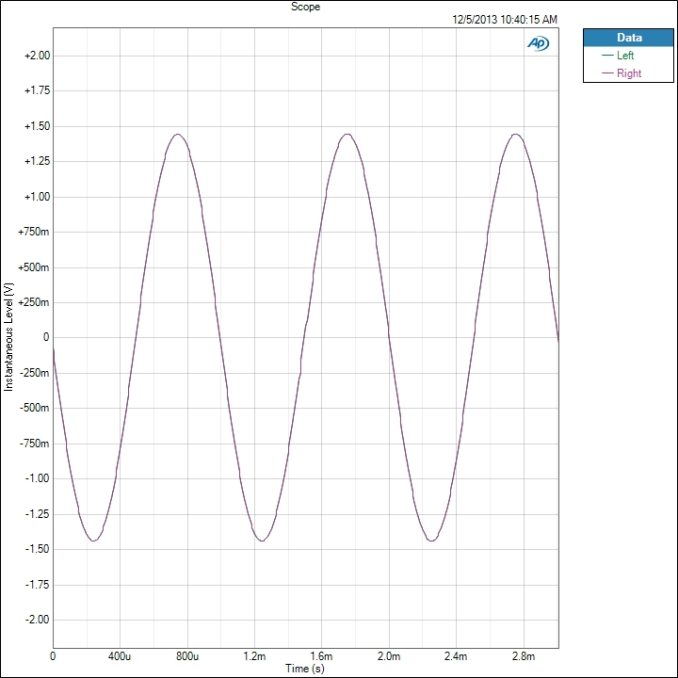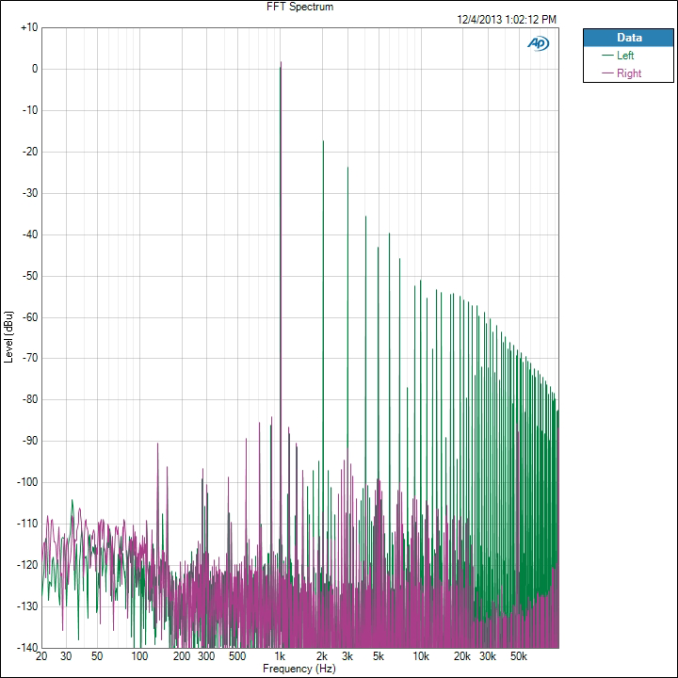Smartphone Audio Quality Testing
by Chris Heinonen on December 8, 2013 5:15 PM EST- Posted in
- Smartphones
- Audio
- Mobile
- Tablets
- Testing
THD+N is a measure of the total harmonic distortion and noise compared to the signal. The lower the number, the less distortion and noise there is relative to the fundamental frequency. THD+N is measured by driving a 1 kHz sine wave at maximum volume. Because there is always some inherent background noise, the THD+N is almost always lowest at maximum output so that is used for the measurement.
There are two results that we take from this: a sine wave and a FFT spectrum. On the sine wave both channels should line up perfectly, and it should be as close to an accurate sine wave as possible. On the FFT we want to see a peak at 1 kHz and everything else as low as possible. The most common artifact you will see are harmonic sidebands at multiples of 1 kHz.
For an example of data that looks good, here is the sine wave of the iPhone 5. We see a sine wave that is good, with channels that overlap perfectly and no deviation. This is what we expect to see.
Now for a different example we look at the Nexus 5. Run at maximum volume we see that the left channel is clipping in the sine wave. Likely the power to the headphone amplifier is not enough to drive both channels and so this is the result. UPDATE: Tested this with 4.4.1 and no change.
The iPhone 5 produces a THD+N ratio of 0.003134% while because of the clipping, the Nexus 5 is producing 13.789197%. Any level over 1% is considered to be past the clipping point of an amplifier and it seems that the Nexus 5 cannot be driven at maximum volume. I tested two samples to verify, and on both the performance is identical.
Now if we look at the FFT for this test, we see how this distortion is showing up. First, the iPhone 5 is very quiet.
There is a 2 kHz peak that is -93 dB below the fundamental frequency, and the 3rd harmonic at 3 kHz is over -109 dB below it. All the harmonics past that are at -120 dB below the fundamental tone. There is some noise out at 50 kHz but this is so far past the level of human hearing that it is safely ignored. Now the Nexus 5 FFT.
We see the right channel, which didn’t clip, looks good. The 2nd harmonic is -111 dB and the 3rd harmonic is -93 dB. On the left channel the 2nd harmonic is only -18 dB and the 3rd harmonic is -24 dB. Even at the 9th harmonic we are still only -52 dB below the fundamental tone. This is causing these incredibly high THD+N numbers that we are seeing on the Nexus 5. We will see more detail of this on a later test as well.
We also chart THD+N vs. Frequency. Here is the chart for the Note 3.
We see that THD+N is basically right below 0.08% for the whole spectrum. It moves up and down slightly, but is very constant. Now here is that Nexus 5 data.
We see that the right channel is around 0.01% THD+N while the left channel, the clipped one, is over 3%. If we ran the Nexus 5 at a lower volume level we would see totally different results, as you’ll find out later, but this is how devices are typically measured.
















188 Comments
View All Comments
Impulses - Wednesday, August 13, 2014 - link
It wouldn't really be a factor, the Bluetooth device's amp would be what's driving your headphones, not the phone's circuitry.blade 7 - Monday, February 17, 2014 - link
while quality of music playback is certainly a major issue, one primary quality question hardly gets any mention, not to speak of objective examination: the quality of the phone call audio itself !it you conduct crucial negotations over the phone - or even if you just flirt with someone on you portable, the quality of voice call transmission can make a huge difference in how you - your message, business proposition, etc - are perceived on the other end of the call, and what impression yout gain from someone calling you. so where in the respective media is a systematic phone-call audio quality assessment ? ( and no, phone call audio quality is not equal to music file playback audio on a smartphone. we are talking much more elements of the phone involved and influencing phone call audio qu. compared to file playback quality.) a lot of modern smartphones sound very poor on voice calls ....
Excerpt - Wednesday, February 26, 2014 - link
Represent RIP city main! You did an amazing and scientific report I have high hopes for future articles and I'm really behind your trailblazing (another reference) the audio quality topic on our electronics!I did a wedding gig with a decent firewire audio interface, ran out of music (as the crowd wanted more current hip-hop) Hooked up my friends iphone and I was a little awestruck. My speaker amp was at about 80% and the iphone 5 was at about 90% volume and the distortion and quality did not seem to dip down at any noticeable amount, through the head phones or the floor speakers. WOW.
I personally just bought the nexus 5 and yes, even at low levels being hooked up to my home stereo (which i do often) the quality and total max dBs are defiencent compared to the iphone. Crap-tastic infact, the left and right speakers even seem noticably out of phase or somehting to that effect. (I'll start using the S.O.'s ipad air if i need an emergency audio source in the future)
Just verifiying this man's findings with real world examples. Thanks!
Excerpt - Wednesday, February 26, 2014 - link
Good point and I think there's some information to be discovered on that topic. However, I wanted to add, carriers are really responsible for increasing the quality of voice. The local recording of a mobile device is much better than the transmitted voice (not withstanding software enhancements eg. noise canceling). Check out, 3GPP and the ITU (International Telecommunications Union). There's some benchmarks that are measuring voice quality calls, but assisted with network simulators, as the network is also an important factor.@paulkind3d - Thursday, March 6, 2014 - link
Call and sound quality are a huge part of mobile phone tech. I'm currently looking into the HTC One as it appears to have set a precedent on sound quality. Personally I am absolutely sick and tired of having to ask "huh, what?" over phone calls due to the crappy little garbage speakers in most cellphones. They are either a) loud enough to hear but are not clear or b) too quiet to hear and are not clear either. Either way hearing calls on cellphones is painful and difficult on every cell phone ive owned to date. I can live with a bulky cell phone if it means better sound personally. Sadly no one else thinks this way. Apparently till a phone is the size of a thumbnail and useless for calling people cellphones makers will not be satisfied.I know that this test does not compare that and is more of a DAC question as the test is geared to headphone sound quality (bonus that one of the test subjects is a grado headphone... grados are amazing... i love my sr325's). None the less, the fact that someone is out there testing audio quality of cell phones means that eventually we may be able to actually hear phone calls when we make/answer.
BTW head-fi.org has many user posts on this same subject. If line level quality is important to you definitely search headfi too. This and many other compares can be found there... http://www.head-fi.org/t/685103/best-phone-for-mus...
H0rtOn - Thursday, May 8, 2014 - link
I read Anandtech alot and have never posted a comment before, but I signed up just to make this post. Please make this a standard part of your phone reviews. I specially missed this part in the review of the HTC One (M8).notsure123 - Friday, April 29, 2016 - link
Old article. I would just like to point out the difference between driving apple headphones (or any headphones for that matter) vs a line input. Not to say this data is inaccurate, it is just not particularly useful in comparing smartphones audio quality. Firstly because I hope no one actually uses their smartphone with headphones at volumes even up to 80% where it might also start distorting. This is too loud and is damaging your hearing. I would like to see the distortion figures when connecting the headphone jack to an auxiliary input rather than a headphone and see how these phones compare (willing to bet its much more similar)Photosynthecis Media - Friday, March 6, 2020 - link
It is important here to differentiate between the microphone and the rest of the audio system if you will because if the microphone is providing the input then its intrinsic response curve will apply kind of like a coefficient to what the audiio sys output is. Whereas an aux input other than the microphone would offer an output only affected by the frequency response characteristics of the amplification system, primarily the speakers, but not the microphones.